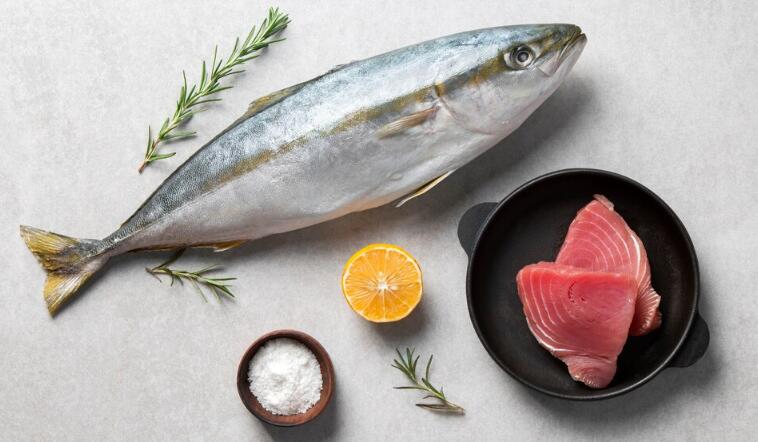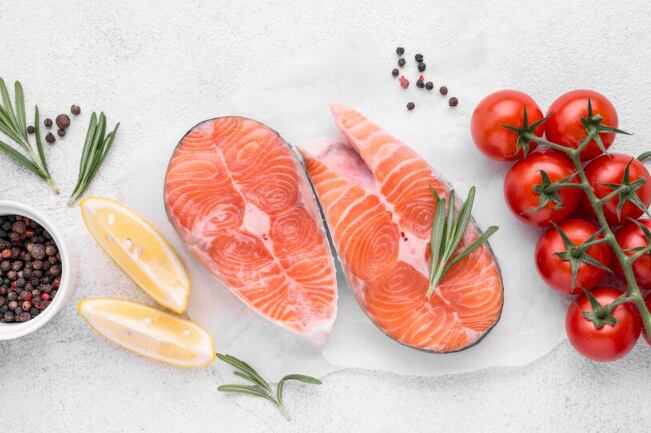Raw fish has become a staple in many global cuisines, particularly in dishes like sushi, sashimi, and poke. These delicacies are widely enjoyed for their fresh taste, unique texture, and perceived health benefits. But is raw fish healthy? Many people believe that eating raw fish provides essential nutrients, such as omega-3 fatty acids and lean protein, without the added fats from cooking. Compared to cooked seafood, raw fish often retains more vitamins and minerals, making it an appealing option for health-conscious individuals.
However, eating raw fish isn’t without risks. While some seafood is safe to consume raw, others may harbor harmful bacteria, parasites, or toxins that can lead to foodborne illnesses. This raises concerns about the dangers of eating raw fish, particularly when it comes to contamination and improper handling. Is sushi raw fish? In most cases, yes—though some sushi dishes include cooked ingredients, many traditional varieties contain raw seafood, making proper preparation crucial for safety.
In this article, we’ll explore the health benefits, risks, and safety precautions of eating raw fish. We’ll also discuss which fish are safest to eat raw and how to minimize potential health risks while enjoying these popular dishes.
Nutritional Benefits of Eating Raw Fish

Eating raw fish offers several health benefits, making it a popular choice for those seeking a nutrient-dense, protein-rich diet. Raw fish is packed with essential nutrients, including omega-3 fatty acids, vitamins, and minerals, which contribute to overall well-being.
Rich in Omega-3 Fatty Acids
One of the biggest benefits of eating raw fish is its high omega-3 content. These essential fatty acids play a crucial role in heart health, brain function, and reducing inflammation. Since omega-3s are heat-sensitive, cooking fish at high temperatures can lead to some nutrient loss. By eating fish raw, you can maximize your intake of these heart-healthy fats.
Higher Retention of Heat-Sensitive Nutrients
When comparing raw fish to cooked fish, raw fish tends to retain more water-soluble vitamins, such as vitamin B12, vitamin D, and vitamin A, as well as important minerals like iodine and selenium. Cooking methods like frying, grilling, or baking can cause the breakdown of some of these delicate nutrients, slightly reducing their bioavailability.
Easier Digestion and Lower Caloric Content
Raw fish is generally easier to digest than cooked fish since it hasn’t undergone structural changes from heat exposure. Additionally, raw fish dishes, such as sashimi or poke, often contain fewer calories and unhealthy fats compared to fried or heavily processed seafood options.
Is Raw Fish Healthier Than Cooked?
While raw fish provides higher levels of certain vitamins and omega-3s, cooked fish has its own advantages, including the elimination of harmful bacteria and parasites. The healthiest option depends on factors like freshness, source, and preparation methods. However, when sourced and handled correctly, raw fish can be a highly nutritious and beneficial addition to a balanced diet.
Common Types of Raw Fish Consumed
Raw fish is a key ingredient in popular dishes like sushi, sashimi, and poke bowls. The type of fish used for these dishes plays a significant role in both flavor and safety. Below are some of the most common types of raw fish enjoyed around the world.
Salmon
Salmon is one of the most popular choices for raw fish dishes, especially in sushi and sashimi. Its rich, tender texture and mild flavor make it a favorite among sushi lovers. However, while salmon is delicious and nutritious, raw salmon carries a higher risk of parasites compared to some other fish. For this reason, it is recommended to purchase sushi-grade salmon, which has been frozen at very low temperatures to kill any parasites.
Tuna
Tuna, especially bluefin and yellowfin, is another staple in sushi and sashimi dishes. Its firm texture and clean taste make it a popular choice for raw preparations. Tuna is often considered one of the safest fish to eat raw due to its relatively low risk of parasites. However, like all fish, it must be sourced from a reputable supplier to ensure freshness and proper handling.
Yellowtail
Yellowtail, or hamachi, is a commonly used fish in sushi and sashimi. Known for its buttery texture and mild flavor, yellowtail is often served raw in many Japanese restaurants. Yellowtail is relatively low-risk in terms of parasites, making it another safe fish to eat raw when sourced from reliable suppliers.
Snapper
Snapper, often found in sushi rolls and sashimi platters, is another popular raw fish. Like yellowtail, snapper has a firm texture and mild flavor that pairs well with soy sauce and wasabi. Snapper is generally safe to eat raw when properly prepared and kept fresh.
Mackerel
Mackerel, or saba, is frequently used in sushi, especially in Japan. It has a rich, oily texture and distinct flavor. However, mackerel is a fish that is highly susceptible to spoilage, and due to its higher fat content, it must be handled and consumed fresh to avoid the risk of foodborne illness.
Which Fish Are Safest to Eat Raw?
The safest fish to eat raw are those that are typically frozen prior to consumption to eliminate harmful parasites. According to reputable sources like the FDA and CDC, the following types of fish are considered relatively low-risk for raw consumption, provided they are handled and stored correctly:
- Tuna (especially bluefin and yellowfin)
- Salmon (if labeled as sushi-grade and previously frozen)
- Yellowtail
- Halibut
- Scallops (when fresh and handled properly)
These fish are generally safe to eat raw when prepared under the right conditions, but it’s important to ensure that they come from a reliable, reputable source to minimize the risks of contamination.
In general, raw fish should always be purchased from trusted suppliers who follow proper handling and freezing procedures to ensure safety. It’s also advisable to check with the establishment to confirm that the fish is labeled as sushi-grade or safe for raw consumption to reduce health risks.
Health Risks and Dangers of Eating Raw Fish

While raw fish is enjoyed by many, it comes with certain health risks that shouldn’t be overlooked. The dangers of eating raw fish are real and can range from mild foodborne illnesses to more severe infections that may require medical attention. Why is raw fish dangerous? The primary concerns include bacterial infections, parasitic infestations, and the potential for food poisoning. Here’s a closer look at these risks, particularly focusing on popular raw fish varieties like salmon, and how they can affect your health.
Bacterial Infections
Raw fish is a potential carrier of harmful bacteria, including salmonella, listeria, and Vibrio vulnificus. These bacteria can lead to severe gastrointestinal distress, causing symptoms like vomiting, diarrhea, fever, and abdominal pain. Some strains of bacteria, such as Vibrio vulnificus, are life-threatening, especially for individuals with compromised immune systems or underlying health conditions. According to the CDC, Vibrio infections from raw or undercooked seafood are associated with a high mortality rate if left untreated.
Parasitic Infestations
One of the biggest risks of eating raw fish is the potential for parasitic infestations, particularly from parasites like anisakis (a type of roundworm), tapeworms, and flukes. These parasites can cause serious health issues, including nausea, abdominal pain, and even organ damage in rare cases. Certain types of fish, such as salmon and mackerel, are more susceptible to parasites and require freezing to kill off potential threats before being eaten raw. Dangers of eating raw salmon include the risk of anisakis larvae, which can burrow into the stomach lining and lead to a condition called anisakiasis. This can cause intense stomach pain, nausea, and vomiting.
Heavy Metal Contamination
Some fish, particularly larger predator species like tuna, can accumulate high levels of mercury, a toxic metal that can cause long-term health issues if consumed in large quantities. While this is more of a concern with cooked fish, those eating raw fish regularly, especially large fish like tuna, may be at risk for mercury poisoning. Symptoms of mercury poisoning include neurological effects like tremors, mood changes, and memory loss.
Food Poisoning and How Long After Eating Raw Fish Will You Get Sick?
Food poisoning is one of the most common consequences of eating contaminated raw fish. Bacteria and parasites can cause gastrointestinal issues, including nausea, diarrhea, and fever. The symptoms can appear as soon as 30 minutes after eating the contaminated fish, though some may take up to 48 hours to manifest. The timeline of illness can vary based on the type of bacteria or parasite involved, but in general, if you experience severe symptoms such as high fever, dehydration, or prolonged vomiting, it’s important to seek medical attention promptly.
Can You Die from Eating Raw Fish?
While the majority of cases of foodborne illnesses from raw fish are mild and resolve with time, can you die from eating raw fish? The answer is yes, although it is rare. Vibrio vulnificus, a bacteria found in raw seafood, can be fatal, particularly in individuals with weakened immune systems. In extreme cases, infections can lead to sepsis, which can be life-threatening without proper treatment. Mercury poisoning from consuming large quantities of contaminated fish over time can also result in severe health complications, though these are less likely to result in immediate death.
Specific Dangers of Eating Raw Salmon
Salmon is widely considered a top choice for raw fish, particularly in sushi dishes. However, it carries its own set of risks. Dangers of eating raw salmon primarily revolve around the potential for parasites such as tapeworms and anisakis. To mitigate these risks, reputable fishmongers and sushi restaurants will freeze salmon at specific temperatures to kill off any parasites before consumption. Even so, improper handling or failure to follow recommended freezing guidelines can lead to potential infections.
Are Raw Fish Dangerous?
The short answer is yes, raw fish can be dangerous if not properly prepared, stored, or sourced from reputable suppliers. However, with proper precautions, such as freezing fish before consumption and ensuring it is labeled as sushi-grade or safe for raw consumption, the risks of eating raw fish can be minimized. Always ensure that you are consuming fish from trusted sources that adhere to the highest safety standards.
In conclusion, while the health risks of eating raw fish are real, they can largely be mitigated through careful sourcing and preparation. Be aware of the potential dangers, and always prioritize food safety to enjoy the delicious benefits of raw fish without the associated risks.
The Science Behind Raw Fish and Foodborne Illnesses
Raw fish can carry a variety of pathogens, including bacteria, viruses, and parasites, which pose a risk of foodborne illnesses. Bacterial pathogens such as Salmonella, Vibrio, and Listeria thrive in seafood and can cause gastrointestinal infections, especially when fish is not stored or handled properly. Viral pathogens like norovirus are also common in raw seafood and can cause severe stomach and intestinal inflammation.
One of the major risks associated with raw fish consumption is parasitic infections, particularly from worms like Anisakis and Diphyllobothrium. These parasites can infect humans when raw or undercooked fish is consumed, leading to conditions like anisakiasis, which causes abdominal pain, nausea, and vomiting.
Symptoms of foodborne illnesses can appear anywhere from 30 minutes to several days after consuming contaminated raw fish, depending on the pathogen involved. Bacterial infections typically present symptoms like nausea, diarrhea, and abdominal cramps within 1-3 days, while parasitic infections may take longer, sometimes up to a week. In severe cases, parasites can migrate through the gastrointestinal tract, requiring medical attention.
Proper freezing of raw fish before consumption can kill most parasites and reduce the risk of illness, making it safer for raw consumption. However, consumers should still be cautious and follow proper food safety guidelines when eating raw fish.
Safety Precautions When Eating Raw Fish

To safely consume raw fish, it’s important to follow strict guidelines to minimize the risk of foodborne illnesses.
Purchase from Reputable Sources
Always buy raw fish from trustworthy sources, such as reputable fish markets, grocery stores, or restaurants. Look for “sushi-grade” or “sashimi-grade” labels, which indicate that the fish has been handled and frozen correctly to kill parasites, making it safer for raw consumption.
Proper Storage
After purchasing, store raw fish at temperatures below 40°F (4°C) and consume it within 1-2 days to prevent bacterial growth. If not eaten immediately, freeze the fish. Freezing at -4°F (-20°C) for 7 days or -31°F (-35°C) for 15 hours will kill parasites like Anisakis and Diphyllobothrium, which can cause infections if ingested.
Freezing Techniques to Kill Parasites
To kill potential parasites, freezing fish is essential before consumption. Freezing fish at the specified temperatures renders most parasites inactive, significantly lowering the risk of infection.
Fish Species Safer to Eat Raw
Some fish are safer for raw consumption due to their lower risk of carrying parasites. Tuna, particularly yellowfin and bluefin, is considered safer for raw consumption. Farmed Atlantic salmon, raised in controlled environments, also has a lower risk of parasites. Other safer species include halibut, sea bass, and scallops, although freezing is still recommended.
By following these precautions, you can enjoy raw fish with reduced risk of illness.
Comparing Cooked Fish vs. Raw Fish
When comparing raw fish to cooked fish, there are distinct advantages and disadvantages to each, particularly in terms of nutrient retention, flavor, texture, and safety.
Nutrient Retention
Raw fish retains more of its natural nutrients, especially heat-sensitive vitamins like vitamin B and some omega-3 fatty acids, which can degrade during the cooking process. Eating raw fish allows for the preservation of these nutrients, making it potentially more nutritious. However, certain cooking methods, like steaming or grilling, can preserve most nutrients while adding other health benefits, such as easier digestion.
Flavor and Texture
Raw fish offers a delicate and clean flavor, often described as more “pure” than its cooked counterpart. Its texture is softer and more buttery, which is a key reason sushi and sashimi are so popular. Cooking fish alters its flavor, bringing out richer, sometimes stronger tastes and giving the fish a firmer texture. For those who prefer stronger flavors and a more varied texture, cooked fish may be more enjoyable.
Safety
Cooking fish has a distinct advantage in terms of safety. Heat kills potential pathogens, such as bacteria (Salmonella, Vibrio) and parasites (Anisakis), making cooked fish less risky to consume. Raw fish can carry these pathogens, posing a risk for foodborne illnesses unless proper freezing methods are used to kill parasites. Cooking offers a more reliable safeguard against these health hazards.
In summary, while raw fish offers unique flavor and nutrient retention, cooked fish provides better safety by eliminating potential pathogens through heat.
Conclusion
Raw fish has become an increasingly popular food choice in dishes like sushi, sashimi, and poke, offering both unique flavors and impressive nutritional benefits. Is raw fish healthy? Yes, raw fish provides essential nutrients such as omega-3 fatty acids, high-quality protein, vitamins, and minerals that support heart health, brain function, and overall well-being. Compared to cooked fish, raw fish often retains more of these beneficial nutrients, making it an attractive option for health-conscious consumers.
However, it is crucial to acknowledge the dangers of eating raw fish. Consuming raw seafood carries risks, including bacterial infections, viral contamination, and parasitic infestations that can lead to foodborne illnesses. Certain fish, such as salmon and mackerel, are more prone to parasites and require proper handling and freezing to ensure safety. Symptoms of foodborne illness can vary, and in severe cases, infections from raw fish consumption can be life-threatening.
To enjoy the benefits of eating raw fish while minimizing risks, it’s essential to follow strict safety precautions. This includes buying sushi-grade fish from reputable sources, ensuring proper freezing techniques to eliminate parasites, and maintaining proper storage and handling practices. When prepared and consumed responsibly, raw fish can be both a delicious and nutritious addition to a balanced diet.

